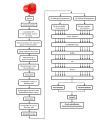Proteomic analysis of ripening tomato fruit infected by Botrytis cinerea
- PMID: 22364583
- PMCID: PMC4874510
- DOI: 10.1021/pr200965c
Proteomic analysis of ripening tomato fruit infected by Botrytis cinerea
Abstract
Botrytis cinerea, a model necrotrophic fungal pathogen that causes gray mold as it infects different organs on more than 200 plant species, is a significant contributor to postharvest rot in fresh fruit and vegetables, including tomatoes. By describing host and pathogen proteomes simultaneously in infected tissues, the plant proteins that provide resistance and allow susceptibility and the pathogen proteins that promote colonization and facilitate quiescence can be identified. This study characterizes fruit and fungal proteins solubilized in the B. cinerea-tomato interaction using shotgun proteomics. Mature green, red ripe wild type and ripening inhibited (rin) mutant tomato fruit were infected with B. cinerea B05.10, and the fruit and fungal proteomes were identified concurrently 3 days postinfection. One hundred eighty-six tomato proteins were identified in common among red ripe and red ripe-equivalent ripening inhibited (rin) mutant tomato fruit infected by B. cinerea. However, the limited infections by B. cinerea of mature green wild type fruit resulted in 25 and 33% fewer defense-related tomato proteins than in red and rin fruit, respectively. In contrast, the ripening stage of genotype of the fruit infected did not affect the secreted proteomes of B. cinerea. The composition of the collected proteins populations and the putative functions of the identified proteins argue for their role in plant-pathogen interactions.
Figures




Similar articles
-
Ripening-regulated susceptibility of tomato fruit to Botrytis cinerea requires NOR but not RIN or ethylene.Plant Physiol. 2009 Jul;150(3):1434-49. doi: 10.1104/pp.109.138701. Epub 2009 May 22. Plant Physiol. 2009. PMID: 19465579 Free PMC article.
-
Ripening-induced defence signalling in Botrytis cinerea-infected tomato fruits involves activation of ERF.F4 by a MYC2-NOR/RIN protein complex.Plant Biotechnol J. 2025 Sep;23(9):4126-4139. doi: 10.1111/pbi.70221. Epub 2025 Jun 26. Plant Biotechnol J. 2025. PMID: 40568857 Free PMC article.
-
Depression of Fungal Polygalacturonase Activity in Solanum lycopersicum Contributes to Antagonistic Yeast-Mediated Fruit Immunity to Botrytis.J Agric Food Chem. 2019 Mar 27;67(12):3293-3304. doi: 10.1021/acs.jafc.9b00031. Epub 2019 Mar 6. J Agric Food Chem. 2019. PMID: 30785743
-
Host susceptibility factors render ripe tomato fruit vulnerable to fungal disease despite active immune responses.J Exp Bot. 2021 Mar 29;72(7):2696-2709. doi: 10.1093/jxb/eraa601. J Exp Bot. 2021. PMID: 33462583 Free PMC article.
-
Botrytis fruit rot management: What have we achieved so far?Food Microbiol. 2024 Sep;122:104564. doi: 10.1016/j.fm.2024.104564. Epub 2024 May 17. Food Microbiol. 2024. PMID: 38839226 Review.
Cited by
-
Unraveling the Molecular Mechanisms of Tomatoes' Defense against Botrytis cinerea: Insights from Transcriptome Analysis of Micro-Tom and Regular Tomato Varieties.Plants (Basel). 2023 Aug 16;12(16):2965. doi: 10.3390/plants12162965. Plants (Basel). 2023. PMID: 37631176 Free PMC article.
-
Proteomic responses of fruits to environmental stresses.Front Plant Sci. 2013 Jan 10;3:311. doi: 10.3389/fpls.2012.00311. eCollection 2012. Front Plant Sci. 2013. PMID: 23335934 Free PMC article.
-
Genome-wide transcriptional profiling of Botrytis cinerea genes targeting plant cell walls during infections of different hosts.Front Plant Sci. 2014 Sep 3;5:435. doi: 10.3389/fpls.2014.00435. eCollection 2014. Front Plant Sci. 2014. PMID: 25232357 Free PMC article.
-
Secretome of the biocontrol agent metarhizium anisopliae induced by the cuticle of the cotton pest Dysdercus peruvianus reveals new insights into infection.J Proteome Res. 2014 May 2;13(5):2282-96. doi: 10.1021/pr401204y. Epub 2014 Apr 17. J Proteome Res. 2014. PMID: 24702058 Free PMC article.
-
Unraveling the in vitro secretome of the phytopathogen Botrytis cinerea to understand the interaction with its hosts.Front Plant Sci. 2015 Oct 9;6:839. doi: 10.3389/fpls.2015.00839. eCollection 2015. Front Plant Sci. 2015. PMID: 26500673 Free PMC article. Review.
References
-
- Elad Y, Williamson B, Tudzynski P, Delen N. Botrytis spp. and diseases they cause in agricultural systems - an introduction. In: Elad Y, Williamson B, Tudzynski P, Delen N, editors. Botrytis: Biology, Pathology and Control. Kluwer Academic Publishers; Dordrecht, The Netherlands: 2004. pp. 1–8.
-
- Van Kan J. Licensed to kill: the lifestyle of a necrotrophic plant pathogen. Trends Plant Sci. 2006;11:247–253. - PubMed
-
- Powell AL, Van Kan J, ten Have A, Visser J, Greve LC, Bennett AB, Labavitch JM. Transgenic expression of Pear PGIP in tomato limits fungal colonization. Mol Plant Microbe Interact. 2000;13:942–950. - PubMed
Publication types
MeSH terms
Substances
Grants and funding
LinkOut - more resources
Full Text Sources

